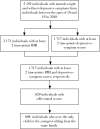[Association between self-control and co-occurrence of depressive symptoms and overweight or obesity during adolescence and early adulthood: A ten-year prospective cohort study based on national surveys]
- PMID: 38864123
- PMCID: PMC11167549
- DOI: 10.19723/j.issn.1671-167X.2024.03.004
[Association between self-control and co-occurrence of depressive symptoms and overweight or obesity during adolescence and early adulthood: A ten-year prospective cohort study based on national surveys]
Abstract
Objective: To explore the association between self-control and the co-occurrence of depressive symptoms and overweight or obesity from adolescence to early adulthood in the Chinese population, and to provide a scientific basis for personalized interventions targeting individuals with different risks in the future.
Methods: From a prospective cohort study that lasted for 10 years: The China family panel studies (CFPS), a total of 608 children and adolescents meeting the following inclusion and exclusion criteria were included as study subjects: (1) Aged 10 to 19 years, at normal weight according to Chinese standards, and without depressive symptom in 2010; (2) Had self-control scores, and with at least two measurements of depressive symptoms and body mass index (BMI) between 2010 and 2020; (3) The only one or the youngest child and adolescent from each family. The co-occurrence of depressive symptoms and overweight or obesity was defined in three ways: Both of the average level of standardized scores of depressive symptoms and BMI Z-scores across multiple measurements over time were at a high level, or both of the trajectories of depressive symptoms and BMI over time based on the latent classification trajectory model (LCTM) belonging to the "risk-type", or individuals had depressive symptoms and overweight/obesity at the last follow-up survey. The multinomial Logistic regression model was used to examine the association between standardized scores of self-control and the co-occurrence of depressive symptoms and overweight or obesity.
Results: The score of self-control was associated with the co-occurrence of depressive symptoms and overweight or obesity when using healthy individuals as the reference group after adjusting for age (years), gender (male/female), area (urban/rural), weekly physical activity duration (high/low), parental education level (college or above/high school or below), parental weight status (overweight or obese or not), and parental depressive symptoms (with depressive symptoms or not), regardless of the definition of the risk population. Specifically, the risk of co-occurrence of depressive symptoms and overweight or obesity was reduced by 33% (95%CI: 14% to 48%, based on the average level across multiple measurements over time) to 78% (95%CI: 6% to 95%, based on the joint trajectories of depressive symptoms and BMI over time) per 1-standard deviation (1-SD) increase in self-control score. In addition, the risk of depressive-symptom-dominant and overweight-or-obesity-dominant was reduced by 25% (95%CI: 4% to 42%, only based on the average level across multiple measurements over time) and 21% (95%CI: 1% to 37%, only based on the joint trajectories of depressive symptoms and BMI over time) per 1-SD increase in self-control score, respectively. The results from sensitivity analysis that defined individuals' weight status according to World Health Organization (WHO) standards were consistent with our main findings.
Conclusion: Individuals with higher self-control scores from adolescence to early adulthood have a lower risk of co-occurrence of depressive symptoms and overweight or obesity, suggesting that personalized interventions for co-occurrence of depressive symptoms and overweight or obesity can be carried out based on self-control scores in the future.
目的: 在我国青春期至成年早期人群中探索自制力与抑郁症状和超重肥胖共病风险的关联,为将来针对不同风险人群开展个性化干预提供依据。
方法: 基于一项长达10年的队列研究——中国家庭追踪调查(China family panel studies, CFPS),纳入2010年10~19岁、中国标准下处于正常体质量、无抑郁症状、有自制力得分,且2010—2020年至少有两次抑郁症状得分和体重指数(body mass index, BMI)、每个家庭中唯一或年龄最小的608名青少年作为研究对象。用整个随访期间平均标准化抑郁症状得分和BMI Z评分均处于高水平,或者基于潜分类轨迹模型(latent class trajectory modeling, LCTM)得到的抑郁症状和BMI随时间的轨迹分类同时属于“风险型”,或者最后一次随访调查时有抑郁症状且超重肥胖三种方式定义抑郁症状和超重肥胖共病人群。采用无序多分类Logistic回归模型分析标准化自制力得分与抑郁症状和超重肥胖共病风险的关联。
结果: 校正年龄、性别、城乡、每周体力活动时长、父母文化程度、父母超重肥胖和抑郁情况后,无论哪种共病定义方式,当以健康人群为参照组时,自制力得分每升高一个标准差,个体患抑郁症状和超重肥胖共病的风险降低33%(95%CI: 14%~48%,基于整个随访期间平均水平)~78%(95%CI: 6%~95%,基于抑郁症状和BMI随时间变化的联合轨迹)。此外,自制力得分每升高一个标准差,个体仅患抑郁症状和仅超重肥胖的风险分别降低25%(95%CI: 4%~42%,仅基于整个随访期间平均水平)和21% (95%CI: 1%~37%,仅基于抑郁症状和BMI随时间变化的联合轨迹)。本研究主要结果与根据世界卫生组织(World Health Organization, WHO)标准定义个体是否超重肥胖时的敏感性分析结果一致。
结论: 青春期和成年早期个体自制力越高,患抑郁症状和超重肥胖共病的风险越低,提示未来可基于自制力开展个性化的抑郁症状和超重肥胖共病干预。
Keywords: Association; Co-occurrence; Depressive symptom; Obesity; Overweight; Self-control.
Conflict of interest statement
Figures




Similar articles
-
The effectiveness of web-based programs on the reduction of childhood obesity in school-aged children: A systematic review.JBI Libr Syst Rev. 2012;10(42 Suppl):1-14. doi: 10.11124/jbisrir-2012-248. JBI Libr Syst Rev. 2012. PMID: 27820152
-
[A prospective cohort study of association between early childhood body mass index trajectories and the risk of overweight].Beijing Da Xue Xue Bao Yi Xue Ban. 2024 Jun 18;56(3):390-396. doi: 10.19723/j.issn.1671-167X.2024.03.003. Beijing Da Xue Xue Bao Yi Xue Ban. 2024. PMID: 38864122 Free PMC article. Chinese.
-
Obesity and the onset of depressive symptoms among middle-aged and older adults in China: evidence from the CHARLS.BMC Public Health. 2018 Jul 24;18(1):909. doi: 10.1186/s12889-018-5834-6. BMC Public Health. 2018. PMID: 30041632 Free PMC article.
-
Prevalence of depressive symptoms in overweight and obese children and adolescents in mainland China: A meta-analysis of comparative studies and epidemiological surveys.J Affect Disord. 2019 May 1;250:26-34. doi: 10.1016/j.jad.2019.02.045. Epub 2019 Feb 20. J Affect Disord. 2019. PMID: 30826491
-
Adults with excess weight or obesity, but not with overweight, report greater pain intensities than individuals with normal weight: a systematic review and meta-analysis.Front Endocrinol (Lausanne). 2024 Mar 6;15:1340465. doi: 10.3389/fendo.2024.1340465. eCollection 2024. Front Endocrinol (Lausanne). 2024. PMID: 38510698 Free PMC article.
Cited by
-
Evaluating the Tree Drawing Test Depression Assessment Scale for adolescent depression screening.Sci Rep. 2025 Jul 1;15(1):20984. doi: 10.1038/s41598-025-99254-8. Sci Rep. 2025. PMID: 40594844 Free PMC article.
References
-
- NCD Risk Factor Collaboration (NCD-RisC) Worldwide trends in body-mass index, underweight, overweight, and obesity from 1975 to 2016: A pooled analysis of 2416 population-based measurement studies in 128.9 million children, adolescents, and adults. Lancet. 2017;390(10113):2627–2642. doi: 10.1016/S0140-6736(17)32129-3. - DOI - PMC - PubMed
Publication types
MeSH terms
LinkOut - more resources
Full Text Sources
Medical
